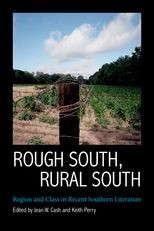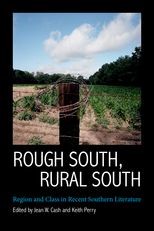Rough South, Rural South: Region and Class in Recent Southern Literature
Rough South, Rural South: Region and Class in Recent Southern Literature
Cite
Abstract
This book describes and discusses the work of southern writers who began their careers in the late twentieth and early twenty-first centuries. They fall into two categories. Some, born into the working class, strove to become writers and learned without benefit of higher education, such writers as Larry Brown and William Gay. Others came from lower- or middle-class backgrounds and became writers through practice and education: Dorothy Allison, Tom Franklin, Tim Gautreaux, Clyde Edgerton, Kaye Gibbons, Silas House, Jill McCorkle, Chris Offutt, Ron Rash, Lee Smith, Brad Watson, Daniel Woodrell, and Steve Yarbrough. Their twenty-first-century colleagues are Wiley Cash, Peter Farris, Skip Horack, Michael Farris Smith, Barb Johnson, and Jesmyn Ward. The book starts by distinguishing Rough South writers from such writers as William Faulkner and Erskine Caldwell. Younger writers who followed Harry Crews were born into and write about the Rough South. These writers undercut stereotypes, forcing readers to see the working poor differently. Other chapters begin with those on Crews and Cormac McCarthy, major influences on an entire generation. Later chapters address members of both groups—the self-educated and the college-educated. Both groups share a clear understanding of the value of working-class southerners.
-
Front Matter
-
“Rough South”: Beginnings
Gary Hawkins
-
From “The Rise of Southern Redneck and White Trash Writers”1
Erik Bledsoe
-
Harry Crews: Progenitor
David K. Jeffrey
-
Elevated above the Real: The Poor White Southerner in Cormac McCarthy’s Early Novels
Marcus Hamilton
-
Tim McLaurin: Universality from Rural North Carolina
bes Stark Spangler
-
Larry Brown: A Firefighter Finds His Voice
Joe Samuel Starnes
-
Dorothy Allison: Revising the “White Trash” Narrative
Emily Langhorne
-
A World Almost Rotten: The Fiction of William Gay1
William Giraldi
-
“Recover the Paths”: Salvage in Tom Franklin’s Fiction
Joan Wylie Hall
-
The Rough South of Ron Rash
Thomas Ærvold Bjerre
-
“Everything Worth Doing Hurts Like Hell”: The Rough South of Tim Gautreaux
L. Lamar Nisly
-
Education Is Everything: Chris Offutt’s Eastern Kentucky
Peter Farris
-
Daniel Woodrell, Ozarker
Shawn E. Miller
-
Kaye Gibbons: Tough Women in a Rough South
Rebecca Godwin
-
Lee Smith: A Diamond from the Rough
Linda Byrd Cook
-
A Country for Old Men: The South of Clyde Edgerton’s Early Novels
Robert Donahoo
-
Jill McCorkle: The Rough South from One Remove
Barbara Bennett
-
“The Spiritual Energy of the Trees”: Nature, Place, and Religion in Silas House’s Crow County Trilogy
Scott Hamilton Suter
-
Steve Yarbrough: Transplanted Mississippian
Thomas E. Dasher
-
Once a Paradise: Brad Watson’s Southern Afterlife
Wade Newhouse
-
Twenty-First-Century Writers: The Rural Southern Tradition Continues
Jean W. Cash
-
Trash or Treasure? Images of the Hardscrabble South in Twenty-First-Century Film
Richard Gaughran
-
End Matter
Sign in
Personal account
- Sign in with email/username & password
- Get email alerts
- Save searches
- Purchase content
- Activate your purchase/trial code
Institutional access
-
Sign in through your institution
- Sign in with a library card Sign in with username/password Recommend to your librarian
Institutional account management
Sign in as administratorPurchase
Our books are available by subscription or purchase to libraries and institutions.
Purchasing information| Month: | Total Views: |
|---|---|
| January 2023 | 1 |




Get help with access
Institutional access
Access to content on Oxford Academic is often provided through institutional subscriptions and purchases. If you are a member of an institution with an active account, you may be able to access content in one of the following ways:
IP based access
Typically, access is provided across an institutional network to a range of IP addresses. This authentication occurs automatically, and it is not possible to sign out of an IP authenticated account.
Sign in through your institution
Choose this option to get remote access when outside your institution. Shibboleth/Open Athens technology is used to provide single sign-on between your institution’s website and Oxford Academic.
If your institution is not listed or you cannot sign in to your institution’s website, please contact your librarian or administrator.
Sign in with a library card
Enter your library card number to sign in. If you cannot sign in, please contact your librarian.
Society Members
Society member access to a journal is achieved in one of the following ways:
Sign in through society site
Many societies offer single sign-on between the society website and Oxford Academic. If you see ‘Sign in through society site’ in the sign in pane within a journal:
If you do not have a society account or have forgotten your username or password, please contact your society.
Sign in using a personal account
Some societies use Oxford Academic personal accounts to provide access to their members. See below.
Personal account
A personal account can be used to get email alerts, save searches, purchase content, and activate subscriptions.
Some societies use Oxford Academic personal accounts to provide access to their members.
Viewing your signed in accounts
Click the account icon in the top right to:
Signed in but can't access content
Oxford Academic is home to a wide variety of products. The institutional subscription may not cover the content that you are trying to access. If you believe you should have access to that content, please contact your librarian.
Institutional account management
For librarians and administrators, your personal account also provides access to institutional account management. Here you will find options to view and activate subscriptions, manage institutional settings and access options, access usage statistics, and more.